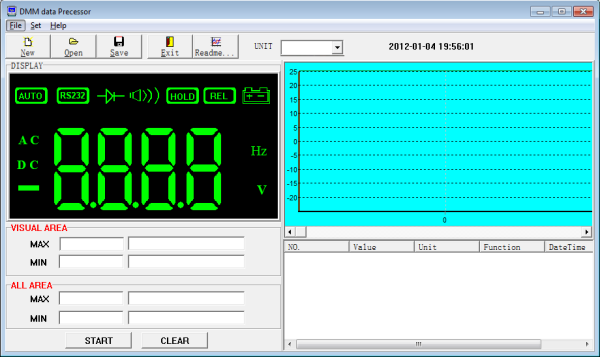Introduction
The Victor 86B DMM is cheap and widely available (http://www.dealexcel.com/victor-vc86b-3-34-digital-multimeter_p1985.html)
and appears a great match for hobbyist projects.
Unfortunately, however no source code for the DMM app is available for the Victor application.
http://www.china-victor.com/Files/Download/setup_86b_multi.rar
and some of the application's features such as saving to a .csv file do not work.

Although some other software for the Victor 86B is available, it is either closed-source
(http://homepage.ntlworld.com/green_bean/coffee/roastlogger/dmmdetails.html)
or incomplete and written in an interpreted language (http://www.daveansell.co.uk/?q=node/44),
therefore it was decided to build a driver program from scratch.
This driver program decodes and displays LCD output from a Victor 86B USB DMM data packet that has been accessed using
HIDAPI (http://www.signal11.us/oss/hidapi/) functions.

The program decodes and displays output from Victor 86B USB DMM based on HIDAPI
(http://www.signal11.us/oss/hidapi/).
The tables show how the USB HID packet (buf) decoded is reverse-engineered using a bench power-supply and other instrumentation to drive
the Victor86B as there is no specification available for the LCD control bits contained in the HID packet.

Background
All table entries are in decimal format and tables contain codes with and without the leading decimal point. In most cases, if 4 of one
on the two characters is set, this means that the decimal point is active.
LCD digits annunciators
- - - -
| | | | | | | |
- - - - - M Hz
| | | | | | | | DC REL V
- - - - AC HOLD m oC u A
. . .
buf 3,10 6,9 5,7 0,2 1 4 8 11 12 13
Digit 4 decode:
.
LCD b3 b10 b10
0 33 79 95
1 17 111 127
2 65 15 31
3 97 239 255
4 81 175 191
Digit 3 decode:
.
LCD b6 b9 b9
0 47 69 85
1 31 101 117
2 79 5 21
3 111 229 245
4 95 165 181
5 239 37 53
6 239 69 85
7 31 229 245
8 111 69 85
9 111 37 53
Digit 2 decode:
.
LCD b5 b7 b7
0 54 84 100
1 38 116 132
2 86 20 36
3 118 244 4
4 102 180 196
5 246 52 68
6 246 84 100
7 38 244 4
8 118 84 100
9 118 52 68
Digit 1 decode:
.
LCD b0 b2 b0
0 75 29 91
1 107 13 123
2 11 61 27
3 235 93 251
4 171 77 187
5 43 221 59
6 75 221 91
7 235 13 251
8 75 93 91
9 43 93 59
LCD Annunciator Decode:
// M Hz
// DC REL V
// AC HOLD m oC u A
// buf 1 4 8 11 12 13
if ((unsigned)(buf[ 1]& 16)) LCD_DC = 1; // DC
if ((unsigned)buf[13]== 140) LCD_V = 1; // Volts
if ((unsigned)buf[13]== 124) LCD_A = 1; // Amps
if ((unsigned)buf[ 8]== 134) LCD_m = 1; // m - milliamps
if ((unsigned)buf[12]== 126) LCD_u = 1; // u - microamps
if ((unsigned)buf[ 4]== 177) LCD_REL = 1; // REL
if ((unsigned)buf[ 4]== 241) LCD_HOLD = 1; // HOLD
if ((unsigned)buf[13]== 172) LCD_Hz = 1; // Hz
if ((unsigned)buf[11]== 191) LCD_oC = 1; // degrees C
if ((unsigned)buf[ 4]== 145) LCD_M = 1; // Mega - ohms
Using the Code
The MS project file is provided as a complete example. It can easily be extended to dump results to a .csv file etc.
Points of Interest
If ever there was an argument for publishing open specifications for instruments with USB interfaces, this is it. A spec would have saved a few days
of experimentation to reverse engineer the storage format. Thankfully though, the HIDAPI library saved a lot of pain that would otherwise have been required
to interrogate the USB interface.
History
Update
For those unable to source a Victor 86B a driver for the Victor 70C has been published at https://github.com/mvneves/victor70c by Marcelo Veiga Neves.
The protocol for the 86B/C and 70C is described quite succinctly here http://sigrok.org/wiki/Victor_protocol.
